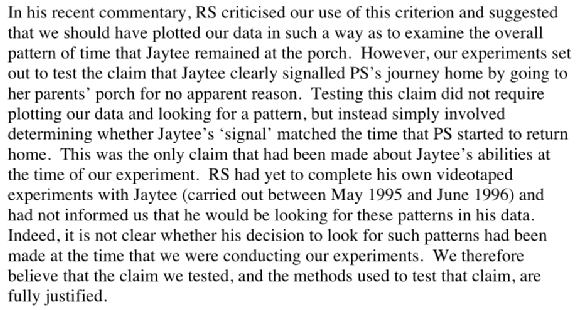Here is the language about defining a hit from the paper by WSM that Shermer referencess::

A moment’s reflection alerts us to the fact that WSM are stating the obvious, and we may wonder why they do not rather go directly to the operational definition used by Sheldrake and Smart in their paper on this dog. And why doesn’t Shermer do that? Does he mean to insinuate that Sheldrake and Smart used some non-operational definition that “might be interpreted after the fact as a signal” and so facilitate confirmation bias? Sadly, answering such obvious questions takes us down a somewhat labyrinthine path.
The unseen gorilla here is the fact that WSM do not look at the SS experiments at all. They instead examin a television special made about Jaytee by the Austrian Broadcasting Corporation. This is listed and linked at 1994, November in the timeline I give earlier. Sheldrake himself refers to this TV show in the Statement to which Shermer is responding, but he states at the same time that the details about Jaytee are given in a scientific paper that he directs Shermer’s attention to with a link. Instead of dealing with the claims made in the 23 pages of that scientific paper, the one to which Sheldrake refers in his Statement, Shermer takes us to the claims made in “A Reply to Rupert Sheldrake” published in the Journal of the Society for Psychical Research. And as we see by reading that paper (quoted from and linked just above) WSM are also not making reference to the basic 23-page paper by Sheldrake-Smart. Instead, they are defending their criticism of the Austrian TV show.
In the next paragraph of that “Reply” by Wiseman, Smith and Milton, we see how they deal with the gorilla.

It is by their statement that “this was the only claim that had been made about Jaytee’s abilities at the time of our experiment” that WSM confront the criticism from Sheldrake that they have not used a reasonable criterion for deciding on a signal from Jaytee that Pam was coming home. Sheldrake, of course, wants them to use the criterion he and Pam Smart used in their hundreds of experiments reported on in their 23-page paper. At issue is What would a reasonable criterion be?
Instead of addressing that issue, however, WSM argue that under the circumstances at the time they did their four experiments they were justified in using the criterion they did. For at that time, SS had not published their paper and the signal WSM used “was the only claim that had been made about Jaytee’s abilities at the time of our experiment.” Furthermore, Sheldrake had not informed them of his using this other criterion for a signal and may not even have decided on it until after their experiments.



